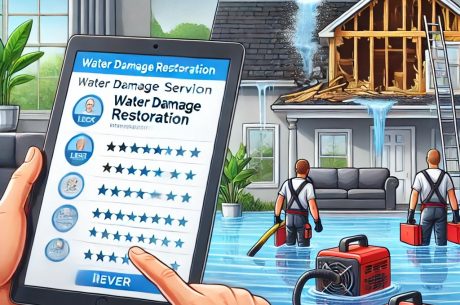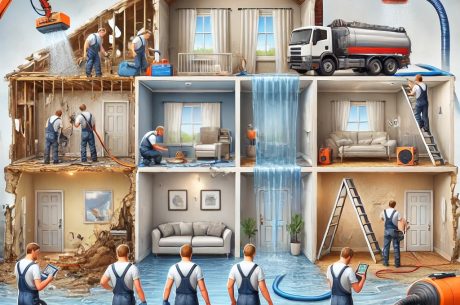Basements, which are mainly used to store items, do laundry, or even extra rooms, become a homeowner’s worst enemy when water damages them. This common problem is a threat to the overall structure of your home, and if not well fixed, it can be a serious threat to your health. The good news is that with the right knowledge and precaution, one can prevent water damage in the basement and also learn how to repair it in case of occurence. This article aims to establish the causes of basement water damage, the prevention measures that can be taken, and the measures that can be taken in the event of occurrence.
Understanding the Causes of Basement Water Damage
Common Sources of Basement Water Damage
To effectively deal with basement water damage, it’s crucial to understand where the problem starts. Water can infiltrate your basement through various means, each requiring different preventive measures:
- Foundation Cracks: With time, the base of your home may begin to crack and this could be as a result of settling, change in temperature or pressure. These cracks can also lead to water infiltration into your basement particularly when it is raining or when snow is melting.
- Improper Grading: If the surrounding soil around your home is not well drained then rain water will collect near the foundation of your home. This wrong slope means that water will accumulate around the foundation and in due course find its way into your basement.
- Unsealed Windows and Doors: The basement windows and doors that are not well sealed are among the biggest entry for water in the home. In the course of a storm or at times when there is high humidity, water can get into the house through these weak areas.
- Plumbing Leaks: Some of the causes of water accumulation in your basement may include; Leaking pipes, burst pipes, faulty water heaters, washing machines among others. These leaks can be very disastrous if they are not detected for a very long time.
- Gutter and Downspout Issues: Blocked drainage systems or downspouts that are not well installed may cause water to accumulate and seep into your foundation. This water can sometimes leak into your basement, causing damage after some time.
The Role of Climate and Geography
There are certain factors that determine the chances of basement water damage, and these include the location of your home and the climate of the area. Such houses are exposed to areas that receive much rainfall, areas that are prone to storms, and areas where there is a lot of snowmelt. Several environmental factors can affect your home’s foundation:
- Rainfall Patterns: In regions where it rains more often or rains heavily, it is necessary to enhance the waterproofing of the basement of homes.
- Snow and Ice Melt: In cold regions, melting of snow and ice produce water that may accumulate around the foundation of the building and if there is no good drainage system, the water may find its way into the basement.
- Soil Type: Some of the common causes include; Some types of soil such as clay hold water which puts pressure on the foundation and thus cracks appear and water gets into the structure.
- Water Table Levels: Houses which are built in areas with high water table are likely to be affected by groundwater flooding. This risk can however be reduced by installing a sump pump.
Effective Strategies to Prevent Basement Water Damage
It is, therefore, very important to prevent such occurrences because dealing with the damages that come with water penetration in the basement is very cumbersome. Here are some effective strategies to keep your basement dry and safe:
Proper Grading and Drainage Systems
A great way of preventing water from getting into your basement is by making sure that the soil surrounding your house has a good slope. The ground should slope down from your foundation so that water does not accumulate around your home but rather drain away from it.
Also, it is important to install a proper drainage system in the house to avoid water accumulation in certain areas. A good gutter system that has downspouts should be installed at the side of the house 5 to 10 feet away from the house to help divert the water from your foundation. Gutter cleaning and downspouts should be done on a frequent basis, particularly in the fall, to eliminate blockage that results in water overflow and basement leakage.
Exterior and Interior Waterproofing
There are two ways of waterproofing the basement, both from the outside as well as from the inside of the house.
- Exterior Waterproofing: This entails putting a layer that does not allow water to pass through on the outer walls of your foundation. To reduce the chances of water seepage through the cracks or porous areas of the foundation walls, one has to excavate around the foundation and then apply asphalt coatings, rubber membranes, or polyurethane sheets. Another simple yet very efficient way of exterior waterproofing is the installation of a French drain system that redirects water flow away from the foundation.
- Interior Waterproofing: If the water has already got into your basement, there is still a way to protect it from future water damage – with interior waterproofing. It is possible to prevent such problems as seepage and condensation by applying waterproof sealants or paints to the interior walls. A sump pump is one of the most efficient ways of waterproofing the interior of a building, especially if the area is prone to flooding. A sump pump is an electric device that pumps out water that collects at the base of a sump basin and discharges it away from the basement to prevent flooding.
Regular Maintenance and Inspection
It is, therefore, important to continue conducting routine maintenance to help avoid basement water damage. Here are some maintenance tips to consider:
- Inspect and Repair Foundation Cracks: Check on the foundation of the house for cracks or gaps at least once in a while. The tiny splits can be filled with epoxy or polyurethane whereas the large ones are best repaired by a professional.
- Monitor Humidity Levels: A dehumidifier should be used to ensure that the humidity levels in the basement are well regulated, especially during the summer season. It is recommended that you maintain the humidity level in the basement to below fifty percent to avoid mold growth and keep the basement dry.
- Clean Gutters and Downspouts: You should clear your gutters and downspouts to allow water to flow freely away from your home’s foundation. This is a practice that should be done at least twice every year, especially after a storm.
- Install Window Well Covers: If your basement has windows with wells, then to avoid water, debris, and even pests getting through, window well covers should be installed. This assists in keeping the basement dry and reduces the chances of water damage in the home.
- Test Your Sump Pump Regularly: It is crucial to check the functionality of your sump pump, and that is why you should test it regularly. Pour water into the hole to see if the pump starts and if the water is removed effectively from the area. In case of any problem, you should address it as soon as possible, and for further assurance, it would be recommended to have a professional inspection once a year.
Steps to Repair Basement Water Damage and Restore Your Space
Despite all the prevention, basement water damage still possibly occurs. When it does, the need to restore it as soon as possible cannot be overemphasized so that the damage caused is reduced and your basement can continue to be used as a part of the house.
Initial Steps After Discovering Water Damage
Basement water damage should be handled with utmost precaution and the following steps should be taken; Shut off electricity supply in the affected area and ensure you use protective gear like rubber boots and gloves in order not to come into contact with the contaminated water. Shut off the source of the water if this is possible and find out where the water is coming from such as a burst pipe, water seepage from the ground or a blocked drain.
When the source is controlled, start getting rid of the water by using a wet/dry vacuum or a sump pump. Dry the area properly by using dehumidifiers and fans in order to eliminate as much moisture as possible. This step is important because, as a rule, mold begins to appear in the house within 24 to 48 hours after the water damage. To use in filing a claim to the insurance company, capture pictures and videos of the affected areas.
DIY vs. Professional Help
When it comes to repairing basement water damage, deciding whether to handle the repairs yourself or hire a professional depends on several factors: When it comes to repairing basement water damage, deciding whether to handle the repairs yourself or hire a professional depends on several factors:
- DIY Repairs: If the damage is slight and is only localized to a particular part of the house, you may be able to do the repairs on your own. Other tasks like pulling out the wet drywall or floor, applying mold proofing chemicals and sealing of small cracks can be done if one is well equipped with the right tools and protective wear.
- Professional Restoration: Severe damage, especially where the water involved is dirty, such as sewage water, should be left to the professionals. Basement flood cleanup professionals are equipped with the right equipment, skills, and knowledge for the effective drying, cleaning, and restoration of your basement. To get the best water damage restoration services in the Rochester Hills area, PuroClean of Rochester Hills is the best to hire. Their team is ready to address the worst water damage situations and guarantee that your basement will get the best treatment it needs to get back to its original state in the shortest time possible.
Conclusion
Water damage in the basement is a major problem that should be addressed before it becomes a worse problem, and we should learn how to prevent it. Knowing the causes, putting into place measures that can help in preventing such occurrences and what measures to take when the unfortunate happens will go a long way in ensuring your home is safe for your family. It is, therefore crucial to ensure that you have the right grading, waterproofing, and regular maintenance of your basement to ensure that your home is safe from floods.




 PuroClean of Rochester Hills
PuroClean of Rochester Hills